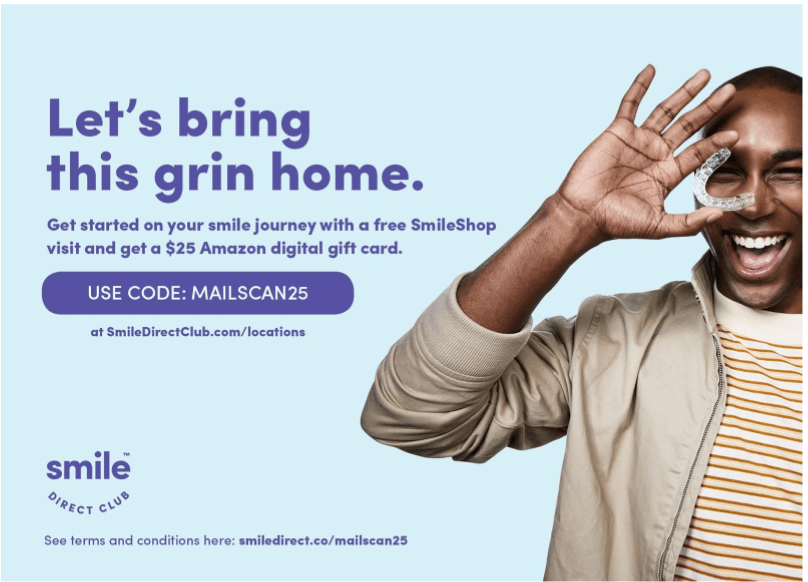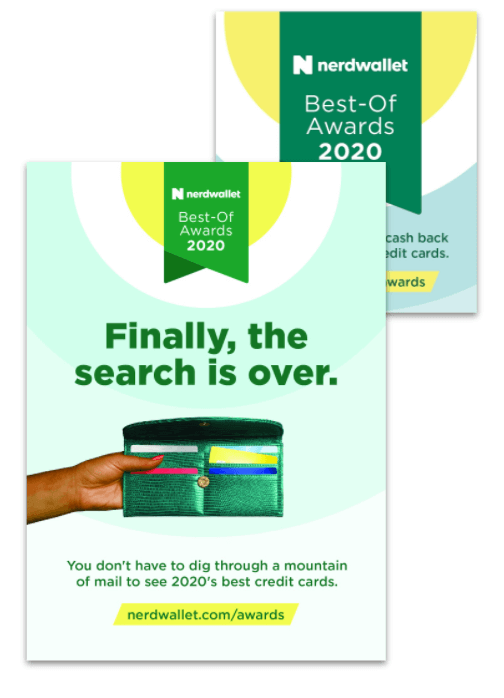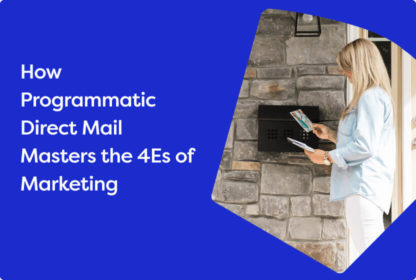At PebblePost, we’re huge fans of the Programmatic Direct Mail postcard — and for a good reason. On average, postcards outperform compared to other direct mail mediums, especially for high-value consideration items (from Direct Mail and the Shopping Shift).
Postcards typically see a high response rate of 4.25%. They are a worthy investment in driving ROI from your omnichannel marketing strategies, especially when promoting sales, promotions, or new product launches. Not all objectives or verticals require full-page catalogs and help keep costs lower to maximize ROI.
But what makes a Programmatic Direct Mail postcard great? Below we’ve broken down the anatomy of a great postcard and discuss how you can create a direct mail piece that will drive engagement and ROI.
4 Tips for Creating a Great Programmatic Direct Mail Postcard
1. Strong Call to Action
What makes a Programmatic Direct Mail postcard stand out in the mailbox is the call to action. Make sure yours is front and center, clear and concise.
If your call to action is a promo code or discount code, make sure to include it on both sides. This ensures it gets seen by your prospects. Additionally, make sure the code is unique and personalized — something separate from the other promotions you may be running.

2. Drive Engagement with High-Impact Creative
When designing a Programmatic Direct Mail postcard, there are some things you can do to stand out and drive engagement.
First, make sure your design prioritizes clarity. Do not overcrowd postcards with imagery. We’ve seen the best results with big, simple imagery. See this example that ModCloth, a retail brand we work with, has used in the past with great results:

Keep your Programmatic Direct Mail postcards simple. Have a call to action that’s direct, concise, and compelling. A striking photo with a great call to action can grab the recipient’s attention, like the one above.
Here’s another example from a financial services brand we work with:

Rather than complicate with additional copy, add bold imagery and include your brand’s logo and the offer on both the front and back (like the example above) for best visibility and engagement.
Another way to set your creative up for success is to make sure offer codes have an expiration date. This will create a sense of urgency with the consumer and encourage them to act faster.
For example, in one of our campaign tests, PebblePost saw an increase in performance on creatives where the offer expired within 30 days of receipt, compared to an offer that expired two months away. Urgency helps!
A few last tips for high-impact Programmatic Direct mail postcard creative:
- Increase engagement by positioning promotional codes in a place that’s easy for consumers to spot quickly.
- Keep font sizes above 10pt. Anything smaller may not render correctly, and the recipient could easily ignore it.
3. Personalization
This part is actually one of the easiest if you use the PDM® platform. Because Programmatic Direct Mail postcards are triggered by online intent, the result is a relevant and personalized mailpiece based upon your prospect’s recent site visit.
By marrying personalization with recent online behaviors, you can ensure your ad creative is relevant to your target audience and segmented appropriately.
Not only that, the postcard makes it to their mailbox within 2–3 days of the initial site visit when they’re still in the purchase consideration window.
4. The Most Important Part: A Segmented, Tailored Audience
While a segmented, tailored audience does not directly affect a great Programmatic Direct Mail postcard’s creative imagery, it is an essential step in ensuring your creative performs.
By segmenting your audience, not only are you ensuring that they are receiving the most relevant direct mail, but that you’re also reaching an audience that aligns with your campaign objectives.
Leverage the Programmatic Direct Mail Platform to seamlessly activate direct mail campaigns to reach each of your segmented audiences – whether that be recent site visitors who haven’t purchased, net- new customers, email subscribers, or lapsed customers.
Based on these segments, you can choose the PDM Product that meets your needs and tailor your creative to that audience.
For example, use PDM Retargeting to reach your anonymous website visitors that did not convert within 2–3 days of their site visit with a Postcard and an offer for first- time customers that persuades them to come back to the site and purchase.
Alternatively, leverage Lookalikes to identify net-new consumers who share similar attributes to your best customers and send them a high-quality postcard that introduces your brand to increase awareness.
Or, leverage Graph Mail to transform your email subscriber list into household addresses and reach them with a different touchpoint, such as a Bifold of your new product suite, or winback your lapsed customers with a postcard with a compelling offer on their next purchase.
In Conclusion
Programmatic Direct Mail postcards are a great way to reach your prospects and incredibly effective when best practices are implemented. The PebblePost team is always available to answer questions about postcard creative, calls to action, and how to personalize your offers.
If you have used Programmatic Direct Mail postcards, what are some things you’ve implemented and with which you’ve seen success? Have you done something not listed above? Let us know!
To learn more about Programmatic Direct Mail or PebblePost and how it can complement your marketing efforts, please reach out to us at hello@pebblepost.com.



